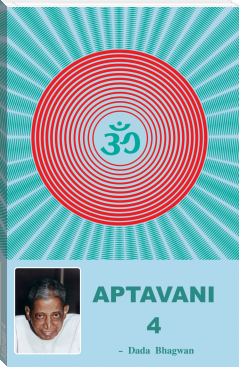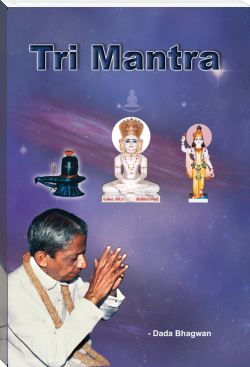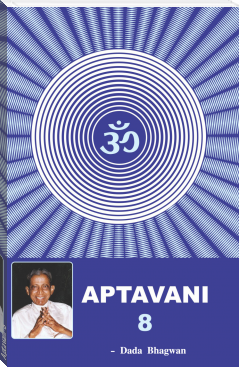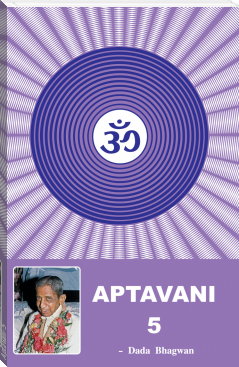Aptavani-4 by Dada Bhagwan (e reader comics .txt) 📖

- Author: Dada Bhagwan
Book online «Aptavani-4 by Dada Bhagwan (e reader comics .txt) 📖». Author Dada Bhagwan
If there is the easiest thing in this world, it is the way to moksha. An ox will go from the farm to the home easily, but it will have to be forcibly pulled to the farm. Moksha is our own home. The world is a ‘farmer’s field’ to be ploughed; except here, there are the horrible physical difficulties, obstacles, and the complications of the interfering intellect(buddhi). And in our own ‘home’, there is no vikalp (the belief of ‘I am Chandubhai’); there is absolute bliss, and there is no ‘doership’!
The Self has always been free, and has never been bound. Bondage seemingly appears because of illusion. By the grace of the Gnani, this illusion is dispelled and the awareness of liberation occurs!
[24] Conviction On the Path to Moksha
To attain moksha:
What is the religion? Religion of the Self.
What is the attire? Any that you like.
What is the place? Place of the Vitarag (One who is free from attachment- abhorrence)!
In what state? In the state of Vitaragata!
In which sect? Where there is no partiality!
How to identify the One who is continuously the
sadguru ? Self; the ultimate guru! His speech is unprecedented, unparalleled and yet it leads one to the experience of the Self.
What is the conviction There the wandering Soul rests.
(pratiti)?
What is the characteristic A state free of kashays (inner of moksha? enemies of anger, pride, deceit and greed).
In these times, where is The Revered Gnani Purush
the end? Dadashri.
How to attain it? With absolute humility (param vinaya).
Where can one attain right From the sadguru,who is free vision? from kashays.
How can one practice From a kashay-free sadguru.
religion?
What is the tool of Being ready and aware for religion? liberation.
What is the definition of That which reduces kashays.
religion?
What is the easy way to To serve the kashay-free
moksha ? Gnani.
What are the means through Through the Knowledge of the which to get moksha? Self.
Does the worldly life No, Ignorance of the Self is the obstruct moksha? obstruction.
In the path to moksha, is Yes, to prevent obstructions in the there a need to worship the path.
ruling deities?
In Jainism, is the fourth day correct or the fifth, for fasting? The one that is suitable is correct. Whichever one that leads to religion (dharma) is correct. The one that causes adharma is wrong.
Who is considered a Jain? The one who has heard the speech of the Jina or the Jineshwar (absolute Self-realized). Having heard it, having faith in it, and following it completely, is a saint (sadhu). The one who follows it partially is a devout follower (shravak).
[25] I and My
“Separate ‘I’ and ‘My’ with the Gnani’s ‘separator’. ‘I’ is immortal. ‘My’ is mortal.”
~ Gnani Purush Dadashri
Wherever there is the attachment of ‘My,’ if that attachment is removed, then in the end the absolute ‘I’ is found.
“‘I’ is God and ‘My’ is illusion.”
~ Gnani Purush Dadashri
The Gnani establishes the line of demarcation between ‘I’ and ‘My.’
[26] Memory Is Dependent on Raag-Dwesh
Memory is dependent on attachment-abhorrence(raag-dwesh).One will feel harassment from the memory of attachment or abhorrence.
The one, who has no memory of anything other than of the Self, is Vitarag. Because the Gnani is always established in the Self, he has no memory of the world, but he can ‘see’ everything in his vision. Memory is the energy of the non-Self complex (pudgal). Vision (darshan) is the energy of the Self.
That which comes in the memory is acquisition(parigraha). However, if the Gnani comes in one’s memory, that attachment (raag) is prashasta raag (attachment of the highest quality). It is this attachment that will remove the ‘My-ness’ (mamata) from the world, and place it into the Gnani. Therefore, that attachment becomes the reason for moksha.
When there is no attachment for those who offer flowers, and no abhorrence for those who utter obscenities, it is called equanimity(samata). The intention to remain in equanimity (samata bhaav) may lead to an error, but the Knower-Seer state (Gnata-Drashta) will impart constant awareness.
There is satisfaction (santosh) in the worldly life, but there is no contentment (trupti). With satisfaction new seeds can be sown.
[27] Open and Straightforward
True straightforwardness(nikhalasata; purity) is where there is the Knowledge of the Self (Atmagnan). There is no need to read the scriptures. There is the need to become pure!
An extraordinary person would be one who is helpful to every single living being! Such a person rises above the forces of the non-Self complex ( prakruti). Such is the one who attains true liberation!
[28] The Laughter of the Liberated One
The liberated smile (mukta hasya) is the permanent radiance on the face of the completely liberated One (Purush)! The inner tug of war about various things, and the whims of etiquette, keep the smile tensed up. The freedom of a smile is proportionate to the simplicity and fault-free state! Where there is Vitaragata, there is the entirely liberated smile!
[29] Worry: Equanimity
Worries create ‘causes’ for a life in the animal kingdom.
When the Gnani is sitting, he touches God; while the person who sits near the Gnani, is sitting very close to God! What else can be there, other than pure blissful silence and peace?
[30] Saiyam Parinam
The Lord does not consider external restraints as saiyam. When not a single evidence or result of the non-Self arises, then it is called completesaiyam (control of kashays: anger-pride-deceit-greed). The result that is there when there is no anger, pride, deceit or greed is called saiyam parinam (absence of kashay reaction). It is only through saiyam that the energy of the Self manifests.
[31] The Laws of Fulfilling Desires
The nature of the mind is to find something new each day. When all kinds of desires arise within, Nature says, “All your requests will be granted, but at our (Nature’s) convenience!” If something becomes available upon desiring it, then it will take one on a downward path. On the other hand, if there is a desire for something that is not easily available; it will take one on an upward path.
[32] The Habit of Watching Television (TV)
The human body is attained after great and strenuous effort and yet, one spends it according to one’s understanding. Lord Krishna has said the same thing in the Gita that people are wasting their time in meaningless activities. Because of lack of understanding, precious human lifetime is snatched away and all the time is wasted.
[33] Greed
The one who has everything, but is still searching for more, is called greedy. The knot of greed is broken by saying, “Whatever is there for me in the ‘scientific circumstantial evidence’, let it be.”
[34] Let Go of the Reins
Even for a moment, one cannot let go of the reins of the ‘horses’ of the five senses. On a downward slope, one loosens the reins, instead of tightening them, and at an incline, instead of loosening the reins, one tightens them! This is why the Gnani Purush gives you the practice of handing over the reins to vyavasthit (‘scientific circumstantial evidence’); while all you have to do is just ‘see’.
By practicing this every Sunday of the week, you will begin to understand ‘scientific circumstantial evidence’ in its exactness: what one’s conduct is like, what type of ‘record’ is playing in one’s speech. One has to ‘see’ all that; ‘see’ the mind and ‘see’ the ‘Self’. Absolute knowledge ( Kevalgnan) unfolds in relation to the degree to which the mind, speech and body are ‘seen’ as separate. One does not have to dismiss or change the activity of the mind, speech and body; one only has to ‘see’
ImprintText: Dada Bhagwan Aradhana Trust
Images: Dada Bhagwan Aradhana Trust
Publication Date: 07-07-2017
All Rights Reserved





Comments (0)